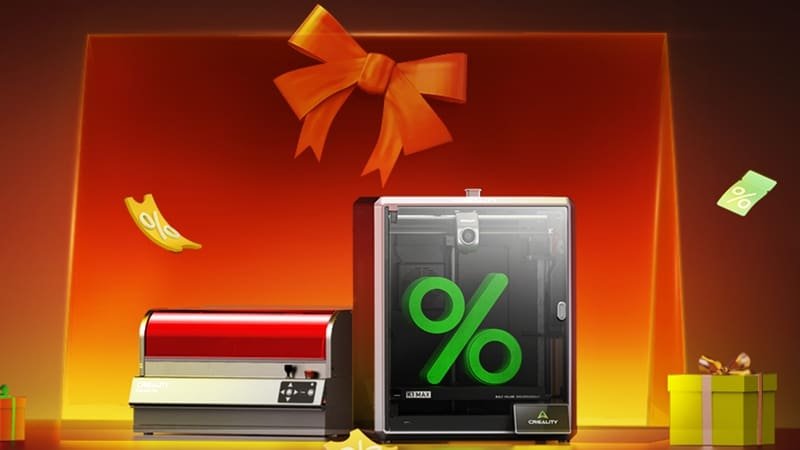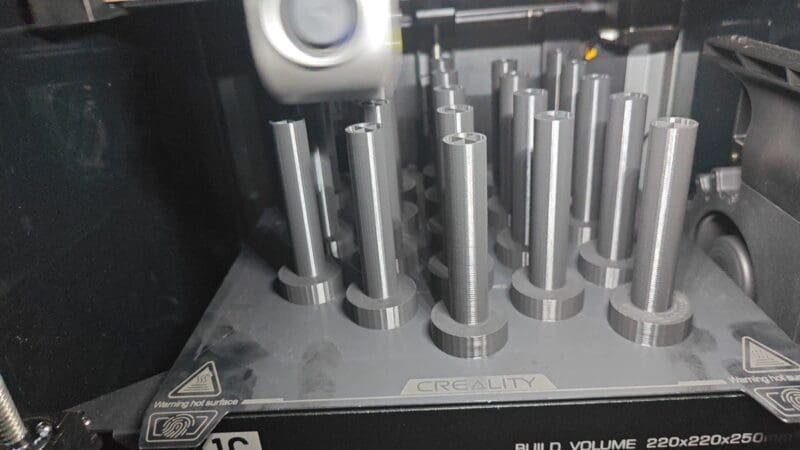Creality K1C vs K1: A Comprehensive Comparison
👋Hot Off the Press at 3DPadvisor! Dive into the world of 3D printing with us, your trusted guide for top-notch reviews and insights. Exciting news – we’ve launched a Facebook group to bring you the best deals on the web for printers, ensuring you get top quality without breaking the bank.
Looking for exclusive discounts on 3D printers, lasers, and engravers? Click here now!
Can’t find the deal you need? Don’t sweat it! Email me directly at paul@3dpadvisor.com, and we’ll hook you up with a sweet deal.

Introduction
Creality has established itself as a leading brand in the 3D printing industry, known for producing high-quality and innovative printers. The K1C and K1 are two of their flagship models, offering impressive features and capabilities for both beginners and experienced users.
In this article, we will explore the key differences and similarities between the Creality K1C and K1, helping you make an informed decision when choosing the right 3D printer for your needs. From physical characteristics to printing parameters, filament support, user-friendly design, and software and connectivity options, we will cover all the essential aspects to help you understand the strengths and weaknesses of each model.
But remember, whether you choose the K1C or the K1, you can expect exceptional performance and outstanding print quality. Currently, the K1C 3d printer is priced at $599 and if you’re interested in getting one, it’s the best time because they’re having an early bird sale of $559, ending on Feb. 6. Applying the below discount, would be around $499.
Creality K1 series 3d printer 6% coupon code: CQ5TCVPR
Creality K1C vs K1: Key Features
The Creality K1C and K1 are two powerful 3D printers that offer a range of impressive features. Both models are known for their high-speed printing capabilities and exceptional print quality. Here are some key features that set them apart:
Filament Compatibility
Both the K1C and K1 support a wide range of filaments, including ABS, PLA, PETG, TPU, PA, and PC. However, the K1C takes it a step further by offering excellent support for carbon fiber reinforced filaments like PLA-CF and PA-CF. This allows users to create stronger and more durable prints for industrial applications.
- 【More Powerful Physical and Mechanical…
- 【Higher Toughness】With higher tensile strength…
- 【Environmentally friendly】Hyper PLA Filament…
- 【Dimensional Accuracy & Consistency】Based on…
- 【Wide Compatibility】Due to high-quality…
- 🦾 Stiff, Strong & Heat Resistant: Polymaker…
- 👉 Wide Application: PolyMide PA6-CF is strong,…
- 🧵 Tangle-Free & Resealable Bag: Our PA6-CF…
- ⚙️ Printing Settings: Nozzle: 280-300°C; Bed…
- ⚠️ Note: An abrasion-resistant nozzle is…
Printing Speed
The K1C and K1 are both designed for speed, with a maximum print speed of up to 600mm/s. This means that users can significantly reduce printing times and increase overall efficiency compared to traditional 3D printers. The high acceleration rate of 20,000mm/s² allows for quick and precise printing, delivering exceptional results in a fraction of the time.
User-Friendly Design
Both the K1C and K1 feature an intuitive touchscreen interface, making it easy for users to operate and manage various functions. The printers also come with automatic calibration for hassle-free leveling, ensuring that the print bed is always perfectly aligned. This eliminates the need for manual adjustments and saves valuable time.
AI Camera
The K1C comes standard with an AI camera, which allows for intelligent monitoring of the printing process. The camera can detect and alert users of any issues that may arise during printing, ensuring a smooth and successful print every time. This feature provides peace of mind and allows users to remotely monitor their prints from anywhere.
- Real-Time Monitoring with Advanced Video Quality:…
- Time-lapse Creation: Use Creality Cloud to…
- Installation & Compatibility: Designed with a…
- Smart AI Detection: Automatically pauses printing…
- Lens Specifications: Field of…
Air Filtration and Quiet Mode
The K1C is equipped with an air purification carbon pack, which effectively absorbs and purifies any odors that may arise from melting materials. This not only creates a more pleasant printing environment but also ensures the safety and well-being of users. Additionally, the printer has a quiet mode that reduces noise levels to a mere 45dB, allowing for a peaceful and uninterrupted work or rest environment.
Comprehensive Software Ecosystem
Both the K1C and K1 are compatible with Creality’s comprehensive software ecosystem, including Creality OS and Creality Print slicing software. This software offers advanced algorithms for intelligent cooling and retraction optimization, as well as the ability to remotely manage 3D printing farms. The printers also support popular slicing software like Cura, Simplify3D, and PrusaSlicer, providing users with flexibility and customization options.
Physical Characteristics
When it comes to the physical characteristics of the Creality K1C and K1 3D printers, both models share some similarities while also offering unique features.
Size and Dimensions
The Creality K1C has a compact and sturdy build, measuring 355 x 355 x 482mm. This size allows for easy placement on any desktop or workbench without taking up too much space. On the other hand, the Creality K1 is slightly smaller, measuring 355 x 355 x 480mm. Both printers are designed to be portable and convenient for users.
Weight
In terms of weight, the Creality K1C weighs approximately 12.4kg, making it lightweight and easy to move around. The K1, on the other hand, weighs slightly more at 12.5kg. Despite their lightweight design, both printers are built with durability and stability in mind.
Display and User Interface
Both the Creality K1C and K1 feature a 4.3-inch color touch screen display. This intuitive interface allows for easy navigation and control of the printer’s settings and functions. Users can easily access and adjust various parameters, making the printing process more efficient and user-friendly.
No products found.
Enclosed Build Chamber
One notable feature of both printers is the enclosed build chamber. This design helps to maintain a stable temperature and protect the printing process from external factors such as drafts or dust. The enclosed chamber also helps to reduce noise levels, creating a quieter and more conducive working environment.
Power and Connectivity
The Creality K1C and K1 both support a wide range of power input, including 100-120V~, 200-240V~, and 50/60Hz. This flexibility allows users to adapt the printer to their specific power requirements. Additionally, both printers offer various connectivity options, such as USB drive and WiFi, allowing for easy file transfer and remote printing capabilities.
Build Plate and Heated Bed
Both the K1C and K1 come with a flexible smooth PEI build plate and a heated bed. The heated bed ensures consistent and even heat distribution, promoting better adhesion and preventing warping or curling of prints. The flexible build plate allows for easy removal of finished prints without causing any damage.
Noise Reduction
Both printers are designed with noise reduction in mind. The Creality K1C features a silent mode that reduces noise levels to a mere 45dB, comparable to the sound of flipping a book. This allows for a more peaceful and undisturbed printing experience.
K1C VS K1 VS K1 Max: Printing Parameters
| Feature | K1C | K1 | K1 MAX |
|---|---|---|---|
| Printing Technology | FDM | FDM | FDM |
| Printing Size | 220×220×250mm | 220×220×250mm | 300×300×300mm |
| Machine Size | 355×355×482mm | 355×355×480mm | 435×462×526mm |
| Packaging Size | 428×428×567mm | 415×415×550mm | 508×508×608mm |
| Product Net Weight | 12.4kg | 12.5kg | 18kg |
| Packaging Gross Weight | 16kg | 16kg | 23kg |
| Printing Speed | ≤600mm/s | ≤600mm/s | ≤600mm/s |
| Acceleration | ≤20000mm/s² | ≤20000mm/s² | ≤20000mm/s² |
| Printing Precision | 100±0.1mm | 100±0.1mm | 100±0.1mm |
| Layer Thickness | 0.1-0.35mm | 0.1-0.35mm | 0.1-0.35mm |
| Extruder Type | direct drive extruder | Dual-gear direct drive extruder | Dual-gear direct drive extruder |
| Filament Diameter | 1.75mm | 1.75mm | 1.75mm |
| Nozzle Diameter | 0.4mm | 0.4mm (compatible with 0.6/0.8mm) | 0.4mm (compatible with 0.6/0.8mm) |
| Nozzle Temperature | ≤300°C | ≤300°C | ≤300°C |
| Heated Bed Temperature | ≤100°C | ≤100°C | ≤100°C |
| Printing Platform | PEI Spring Steel Platform | Flexible build plate | Flexible build plate |
| Leveling | Automatic Bed Leveling | Hands-free auto leveling | Dual hands-free auto leveling |
| Printing Modes | Cloud Printing / LAN Printing / USB Printing | USB drive, WiFi | USB drive, Ethernet, WiFi |
| Display | 4.3-inch Color Touch Screen | 4.3″ color touch screen | 4.3″ color touch screen |
| AI Camera | Standard Inclusion | Optional | Yes |
| AI LiDAR (Laser Radar) | Optional | Optional | Yes |
| Power Loss Recovery | Supported | Supported | Supported |
| Filament Runout Sensor | Supported | Supported | Supported |
| Vibration Ripple Optimization | Supported | Supported | Supported |
| Lighting Kit | Supported | Supported | Supported |
| Auto Sleep | Supported | Supported | Supported |
| Rated Voltage | 100-120V~, 200-240V~, 50/60Hz | 100-120V~, 200-240V~, 50/60Hz | 100-240V ~, 50/60Hz |
| Rated Power | 350W | 350W | 1000W |
| Compatible Filaments | ABS/PLA/PETG/PET/TPU/PA/ASA/PC/PLA-CF/PA-CF/PET-CF | ABS, PLA, PETG, PET, TPU, PA, ABS, ASA, PC, PLA-CF, PA-CF, PET-CF | PLA, PETG, PET, TPU, PA, ABS, ASA, PC, PLA-CF, PA-CF, PET-CF |
| Printing File Format | G-Code | G-Code | G-Code |
| Slicing Software | Creality Print, compatible with Cura/Simplify3D/PrusaSlicer | Creality Print; compatible with Cura, Simplify3D, PrusaSlicer | Creality Print; compatible with Cura, Simplify3D, PrusaSlicer |
| Slicing Supported Formats | STL, OBJ, 3MF | STL, OBJ, AMF | STL, OBJ, AMF |
The Creality K1C and K1 are super cool 3D printers that work great for both newbies and pros. They use FDM tech, which is reliable and user-friendly. These printers have a nice big build area (220x220x250mm) so you can create big and intricate stuff. They’re really precise, with a tolerance of 100±0.1mm, making sure every tiny detail of your design comes out just right.
You can tweak the layer thickness between 0.1mm and 0.35mm depending on your project, whether you want super fine details or quicker prints. Both printers have top-notch extruders (the K1C has an all-metal one and the K1 has a dual-gear one) that feed filament smoothly for great print quality.
They use 1.75mm filament, which is pretty standard, so you’ve got lots of options like PLA, PETG, ABS, and more. Plus, the K1 lets you switch between nozzle sizes (0.4mm, 0.6mm, or 0.8mm) for different print speeds and resolutions.
Both printers can heat their nozzles up to 300°C and their beds up to 100°C, which is awesome for using different materials, even the high-temperature ones, and helps keep your prints sticking to the bed.
Conclusion
In my opinion, both the K1C and K1 come from the same series, deserve a try. With their impressive features, advanced functionalities, and commitment to quality, these two are sure to exceed your expectations. Currently, Creality is having a sale and this price range between K1C and K1 is around $60, I would recommend K1C actually but if the price range is beyond 100, I would prefer K1 and you can get some upgrades to achieve better performance.
DISCLOSURE: THIS POST MAY CONTAIN AFFILIATE LINKS, MEANING I GET A COMMISSION IF you DECIDE TO MAKE A PURCHASE THROUGH MY LINKS, AT NO COST TO YOU. PLEASE READ MY DISCLOSURE FOR MORE INFO.






